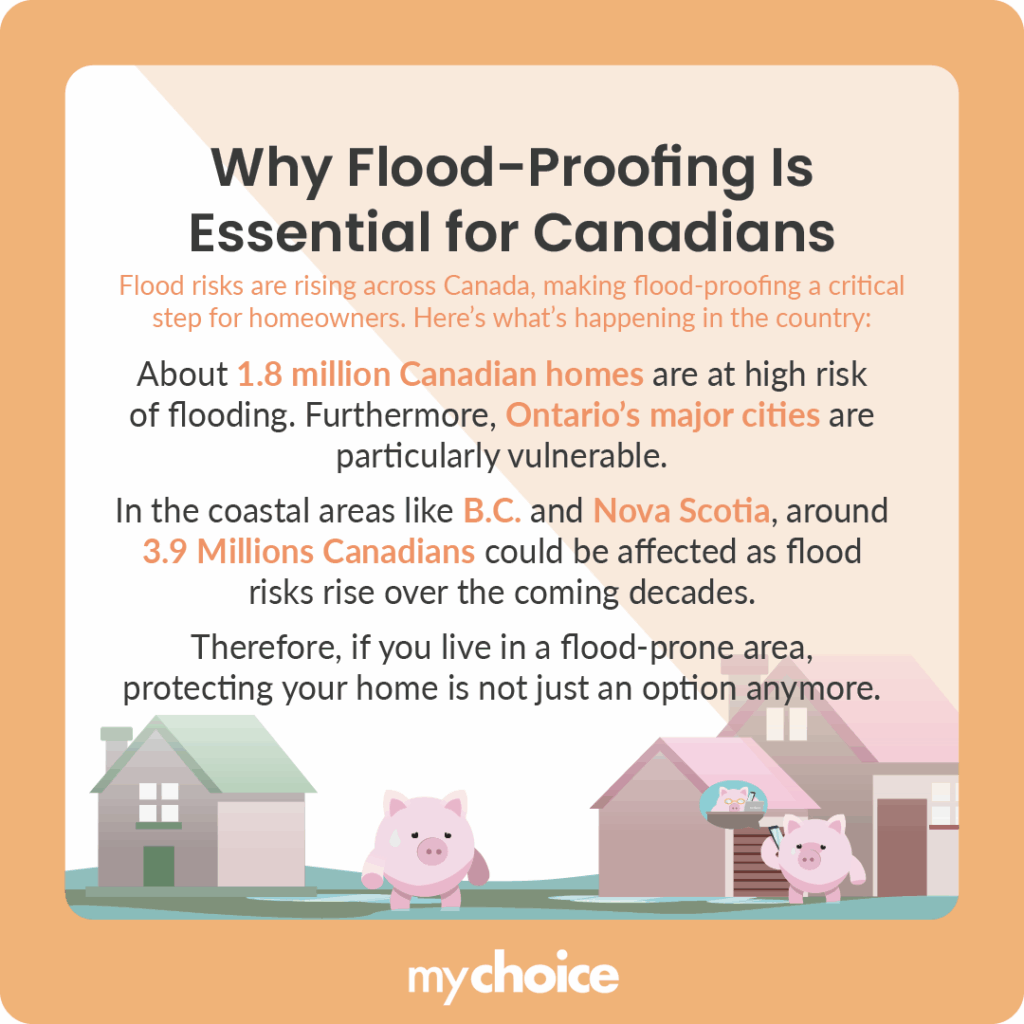It goes without saying that flooding can cause severe damage to your home. However, the damage doesn’t stop once the water is gone. Your home will still be at risk of structural damage, mould, corrosion, and many other things that can be very costly to repair. Since prevention is always better than the cure, let’s take a look at how to flood-proof your house.
Why Flood-Proofing Isn’t Optional Anymore
The Canadian Climate Institute estimates that 10% of Canadian households, which is approximately 1.8 million homes, are at high risk of flooding. Ontario is one of the provinces most vulnerable to flooding, with our research indicating that many of its largest cities have a flood risk score of 4 or higher.
Canada’s coastal communities, including those in British Columbia and Nova Scotia, are also at high risk of coastal flooding, with an estimated 3.9 million Canadians residing in areas projected to be affected over the next century.
This number is likely to go up as the years pass, which means if you live in a potentially flood-prone area, flood-proofing isn’t optional anymore.

Flood-Proofing Tactics That Actually Work
Now that we’ve established that flood-proofing is essential, let’s get to work. We’ll divide our flood-proofing tips into two parts: inside and outside the house.
Inside the House
| Tactic | Why It Matters | Typical Cost | Who Needs It |
|---|---|---|---|
| Install a sump pump with battery backup | Sump pumps prevent excess water from pooling in the basement keeping it from flooding, while the battery backup ensures it has enough power to do its task | Around $1,200 to $2,500 depending on the pump type and installation complexity | People living in areas prone to flooding or heavy rain whose homes include basements and crawl spaces |
| Add backwater valve | Backwater valves carries sewage away from your house, preventing sewer backup | Around $500 when included with the initial home construction, $2,000 to $5,000 if added later | People whose homes have fixtures located below street level |
| Seal cracks in foundation, walls, and floors | Prevents water from seeping in through the cracks and causing floods | Typically starts from $200 per hour if done by a professional | People whose homes have mild structural damage and cracking |
| Raise major appliances | Prevents flood water from hitting and damaging your appliances | Can be free if done yourself using concrete blocks | People whose major appliances are located on the first floor or basement |
| Install smart water sensors | Detects water levels and alerts you if a flood is about to happen | $50-80 for a set of 4-5 devices | Anybody who can’t regularly check water levels |
Outside the House
| Tactic | Why It Matters | Typical Cost | Who Needs It |
|---|---|---|---|
| Extend downspouts 2–3 metres away from foundation | Extending your downspout ensures rainwater and melted snow are carried far enough away from your house so they won’t land on your foundations | $100-$300 per downspout with contractors, cheaper if DIY | People whose houses experience heavy rainfall or snow |
| Regrade landscaping | Regrading your landscaping creates a slope away from the house, directing water to the street or drainage area | Regrading your land typically costs $0.08 to $2 per square foot, depending on the contractor | People whose yard slopes inward toward the house |
| Clean gutters twice a year | Removes debris that can cause overflowing water, preventing foundation damage and basement flooding | Roughly $200 per clean | People who gets a lot of debris on their gutters |
| Install window well covers | Covering window wells keep rain and snow away from the wells, preventing moisture buildup and potential flooding | Around $500 to $1,000, depending on contractor | People with windows below ground level |
| Add temporary barriers or sandbags | Covering flood-prone areas so water flows somewhere else | Pre-filled bags go for about $7.5 per bag, and you can place them yourself | People who want to direct waterflow away from the house |
How to Best Protect Your House Based on Where You Live
Different areas of Canada face different flood risks, each requiring different flood-proofing measures. Here’s an overview of the varying flood risks across Canadian regions, what your home insurance can cover, and how you can protect your home.
| Region | Main Flood Risk | What Insurance Covers | What to Add Through Flood-Proofing |
|---|---|---|---|
| Southern Ontario (Toronto, Ajax, Ottawa) | Heavy rain, urban overland flooding | Overland flooding if you purchase overland water coverage | Regrade landscape, install barriers like sandbags, place sump pumps |
| Prairies (Regina, Calgary, Winnipeg) | River overflow, snowmelt | River overflows and snowmelt if you have overland water coverage | Improve drainage with backwater valves and raise essential appliances |
| Atlantic Canada (Halifax, Moncton, St. John’s) | Coastal storm surge, sea level rise | Storm damage through basic home insurance, saltwater floods through flood coverage | Improve drainage with backwater valves, elevate appliances, waterproof foundation, seal cracks |
| British Columbia Coast (Vancouver, Delta, Richmond) | Sea-level rise, tidal flooding | Saltwater floods through flood coverage | Elevate appliances, grade landscape to drain water away, install backwater valves |
| Northern Communities (Yukon, NWT) | Permafrost melt, river ice jams | Snow-related flooding through overland water coverage | Seal foundation cracks, elevate appliances, install backwater valves |
Key Advice from MyChoice
- Learn about the flood risks in your area and implement flood-prevention measures to mitigate them.
- Check your home insurance policy to ensure you have the appropriate flood protection coverages, like overland water coverage for freshwater floods and flood coverage for saltwater floods.
- Keep an eye on local channels so you don’t miss any flood-related announcements.








